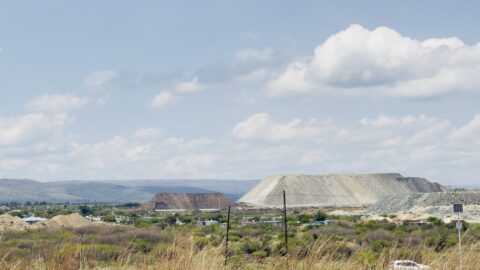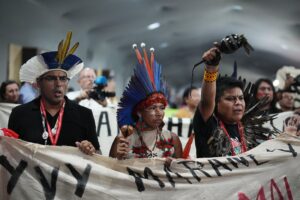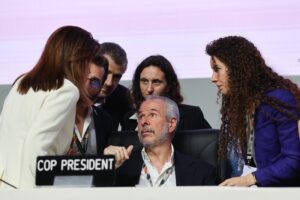In the early 2000s, a new field of climate-science research emerged that began to explore the human fingerprint on extreme weather, such as floods, heatwaves, droughts and storms.
Known as “extreme event attribution”, the field has gained momentum, not only in the science world, but also in the media and public imagination. These studies have the power to link the seemingly abstract concept of climate change with personal and tangible experiences of the weather.
Scientists have published more than 400 peer-reviewed studies looking at weather extremes around the world, from wildfires in the US and heatwaves in India and Pakistan to typhoons in Asia and record-breaking rainfall in the UK. The result is mounting evidence that human activity is raising the risk of some types of extreme weather, especially those linked to heat.
To track how the evidence on this fast-moving topic is stacking up, Carbon Brief has mapped – to the best of our knowledge – every extreme-weather attribution study published to date.
Carbon Brief’s analysis reveals:
- 71% of the 504 extreme weather events and trends included in the map were found to be made more likely or more severe by human-caused climate change.
- 9% of events or trends were made less likely or less severe by climate change, meaning 80% of all events experienced some human impact. The remaining 20% of events and trends showed no discernible human influence or were inconclusive.
- Of the 152 extreme heat events that have been assessed by scientists, 93% found that climate change made the event or trend more likely or more severe.
- For the 126 rainfall or flooding events studied, 56% found human activity had made the event more likely or more severe. For the 81 drought events studied, it’s 68%.
First published in July 2017, this article is the fifth annual update (see endnote) to incorporate new studies. The aim is that it serves as a tracker for the evolving field of “extreme event attribution”.
Using the map
The map above shows 504 extreme weather events and trends across the globe for which scientists have carried out attribution studies. The different symbols show the type of extreme weather; for example, a heatwave, flood or drought. The colours indicate whether the attribution study found a link to human-caused climate change (red), no link (blue) or was inconclusive (grey).

Use the plus and minus buttons in the top-left corner, or double click anywhere, to zoom in on any part of the world. Click on a symbol to reveal more information, including a quote from the original paper to summarise the findings and a link to the online version.
The filter on the left allows users to select a specific type of weather event to look at or, for example, only those found to be influenced by climate change.
The filter can also be used to highlight extreme events from a particular year. (Note: earlier versions of this map classified events by the year that the study or analysis was published.) To isolate studies that assess the changing trends of weather extremes, click the “trend” box in the filter.
The software used to make the map currently only works with a Web Mercator projection (as used by virtually all major online map providers). It is worth noting that this – like all map projections – offers a somewhat distorted view of the world.
It is important to note that the weather events scientists have studied so far are not randomly chosen. They can be high-profile events, such as Hurricane Harvey, or simply the events that occurred nearest to scientific research centres. (More on this below.)
The map includes three different types of studies. The circles and hexagons on the map indicate papers published in peer-reviewed journals. The different shapes refer to whether the study considers an individual extreme event (circles), such as a wildfire or storm, or whether it analyses longer-term trends in extreme weather (hexagons), such as the change in frequency of flooding or marine heatwaves over time.
The third shape – triangles – indicate rapid attribution studies. These are quickfire assessments of the climate change contribution to extreme weather events, published online shortly after an event concludes. (More on this below.)
Finally, it is worth noting that some of the icon locations are approximate – particularly for studies that cover large regions. For example, global studies can be found grouped together in the middle of the Atlantic Ocean.
Extreme weather types
The events and trends shown on the map are covered by 431 individual scientific papers or rapid studies. Where a single study covers multiple events or locations, these have been separated out into individual entries on the map.
Combining the evidence over the past 20 years, the literature is heavily dominated by studies of extreme heat (30%), rainfall or flooding (25%) and drought (16%). Together, these make up more than two-thirds of all published studies (71%). The full list is available in this Google sheet.
As the chart below shows, the number of extreme events studied has grown substantially over the past 10-15 years. Note that formal studies typically follow a year or so after the event itself as the writing and peer-review process for journal papers can take many months.
The majority of studies included here have been published in the annual “Explaining extreme events” special issues of the Bulletin of the American Meteorological Society (BAMS). Each bumper volume typically contains around 15-30 peer-reviewed studies of events from the previous year. Other studies have been found through the Climate Signals database and online searches through journals. This update includes studies published up to the end of May 2022.
(Note: The map currently only includes studies published in English.)
Specific types of event can be displayed in the chart below by clicking on the category names at the top.

Number of attribution studies by extreme weather event type and year. Note: the total number of events dipped in 2017 because the Bulletin of the American Meteorological Society special report for that year was published in early 2018 rather than late 2017. Chart by Carbon Brief using Highcharts.
Most of the categories of extreme weather are self-explanatory, but “storms” and “oceans” require a bit of explanation.
For ease of presentation, the “storms” category includes both tropical cyclones – such as hurricanes and typhoons – and extratropical storms. The “oceans” category encompasses studies looking at marine heatwaves, storm surges and the strength of El Niño events.
Newer categories include “coral bleaching” and “ecosystem services”, reflecting the ongoing developments in attribution science. For example, a rapid attribution study concluded that climate change had “drastically” increased the likelihood of the conditions leading to bleaching of the Great Barrier Reef in 2016 – by at least 175 times. And a 2022 study found that “extremely early” cherry-tree flowering in Kyoto in March 2021 was made “15 times more likely” by climate change.
For this latest iteration of the map, a new category of “compound” extreme events has also been added. This includes, for example, a 2021 study that found climate change had contributed to the “high likelihood” of combined dry and hot events in recent decades over most of China.
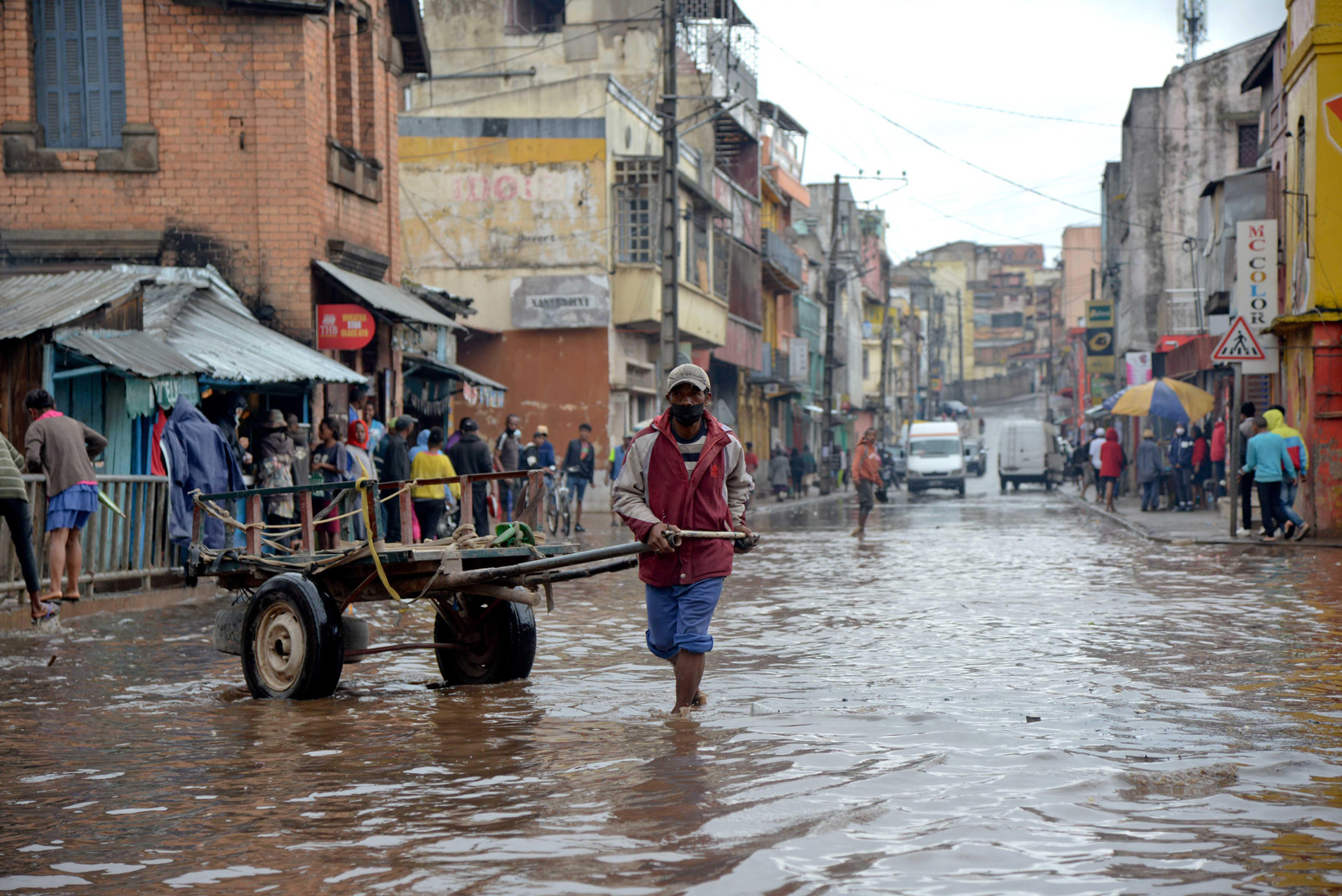
Such studies show that attribution studies are increasingly considering the impacts of extremes, rather than focusing purely on the weather event.
One of the first of these “impact attribution” studies was published in 2016. It estimated that 506 of the 735 fatalities in Paris during the 2003 European heatwave were down to the fact that climate change had made the heat more intense than it would otherwise have been. The same was true for 64 of the 315 fatalities in London, the study said. Health impacts have increasingly become a focus of attribution studies.
Similarly, a 2021 study found that 37% of “warm-season heat-related deaths” across 43 countries between 1991 and 2018 “can be attributed to anthropogenic climate change and that increased mortality is evident on every continent”. Another 2021 study, which the authors unpacked in a Carbon Brief guest post, found that climate change was a “critical driver” of the drought that led to a food crisis in Lesotho in 2007. And a third 2021 study – also the subject of a Carbon Brief guest post – on the rising threat of an “outburst flood” from glacial lakes in the Peruvian Andes found that the retreat of the region’s glaciers was “entirely attributable” to human-caused warming.
This shift towards impacts “is quite significant”, says Prof Peter Stott, who leads the climate monitoring and attribution team at the Met Office Hadley Centre and has been a co-editor of the BAMS reports since they began in 2012. He tells Carbon Brief:
“Impacts are hard to do because you have to establish a significant link between the meteorology and the impact in question. As editors, we’ve been trying to encourage more studies on impacts because it’s the impacts rather than the meteorology per se that tends to motivate these types of study – and if we only have the attribution on the meteorological event then we only have an indirect link to the relevant impact.”
Attribution of climate impacts could even be used in the courts, one 2021 study explained. The authors wrote a Carbon Brief guest post explaining how attribution science can be “translated into legal causality”. They wrote:
“Attribution can bridge the gap identified by judges between a general understanding that human-induced climate change has many negative impacts and providing concrete evidence of the role of climate change at a specific location for a specific extreme event that already has led or will lead to damages.”
Finally, attribution research has also identified the “signal” of human influence in other indicators of climate change, such as increasing average temperature, rising lake temperatures or sea level rise. Recent research has even been able to detect the fingerprint of climate change “from any single day in the observed global record since early 2012, and since 1999 on the basis of a year of data”. These types of studies have not been included in the attribution map as the focus here is on extremes.
Human influence on extreme weather
Of the attribution studies included here, scientists found that human-caused climate change has altered the likelihood or severity of an extreme weather event in 80% of cases studied (71% made more severe or likely and 9% made less so).
In Carbon Brief’s first edition of this analysis in 2017, 68% of events were found to have a human impact (with 63% made more severe or likely and 6% less so).
While these figures are not representative of all extreme weather events – attribution studies have only been conducted on a relatively small number – previous research has taken this broader view. For example, a 2015 study estimated the fraction of all globally occurring heat and heavy rainfall extremes that was attributable to warming. The authors found that around 75% of “moderate daily hot extremes over land” and 18% of “moderate daily precipitation extremes over land” were attributable to the observed temperature increase since pre-industrial times. These fractions are expected to increase with further warming, the authors noted.
There are several ways of carrying out an attribution analysis. (A team of attribution scientists wrote a Carbon Brief guest post in 2021 that unpacks their methods.) One of the most common is to take observations and/or climate model simulations of an extreme event in the current climate and compare them with idealised model runs of that event in a world without human-caused global warming. The difference between the “with” and “without” climate change simulations indicates how the likelihood or severity of that extreme event has changed.
Note that events are classified here as having an human impact if climate change is found to have influenced at least one aspect of that event. For example, a study of the 2011 East Africa drought found that climate change contributed to the failure of the “long rains” in early 2011, but that the lack of “short rains” in late 2010 was down to the climate phenomenon La Niña. This event is, thus, designated as having a human impact.
For the majority of events affected by climate change, the balance has shifted in the same direction. That is, rising temperatures made the event in question more severe or more likely to occur. These events are represented by the red in the chart below. Clicking on the red “slice” reveals that heatwaves account for 40% of such events, rainfall or flooding for 20%, and droughts for 15%. Return to the original chart, and do the same with the other slices to see the proportion of different weather types in each category.

Pie chart showing the proportion of extreme events/studies that were found to have been made more likely/severe by climate change (red segment), less likely/severe (orange), had no link identified (blue) and were inconclusive or lacked sufficient data (grey). Clicking on a segment reveals the makeup of different types of extremes within that category. Chart by Carbon Brief using Highcharts.
In 11% of extreme weather events and trends studied, scientists found no discernible influence from human activity. These are coloured blue in the map and the chart above. For a further 9%, the observational data or modelling techniques used in the study were insufficient to reach a reliable conclusion (shown as grey in the map and pie chart).
In 9% of studied weather events and trends, scientists found climate change had made the event less likely or less severe (pale orange in the chart above).
Unsurprisingly, this category includes blizzards and extreme cold snaps. However, it also features a few studies that suggest climate change has lessened the chances of heavy rainfall, and another that found rising temperatures have made agricultural drought in California less likely.
Drought is complicated (more on this below). Briefly, though, it is worth noting that five other studies looking at different aspects of the California drought over 2011-17 found climate change had played a role. Two found no discernible link (pdf, p7-15), while one was inconclusive (pdf, p3).
Interestingly, a 2020 study analysed the way links between climate change and the California drought were portrayed in US media. It finds that the links were “covered widely in both local and national news”, but notes:
“However, legitimate differences in the methods underpinning the attribution studies performed by different researchers often resulted in a frame of scientific uncertainty or disagreement in the media coverage.”
As the case of California’s drought shows, it is often necessary to dig deeper to understand the full picture. The rest of this article looks at the evidence for the three most-studied types of extreme weather – heatwaves, heavy rain and floods, and droughts – as well as some of the main issues in event attribution, and where the field as a whole is heading.
Heatwaves
The attribution map includes studies of 152 extreme heat events, of which 142 (93%) have been made more likely or more severe because of climate change. No studies have found a heatwave that has been made less severe by climate change, while studies of two events (1%) identified no influence and a further eight (5%) were inconclusive.
In recent years, studies have shown that several heat extremes would have been impossible or virtually impossible without human influence on the climate. These include Siberia’s heatwave of 2020, the Pacific north-west “heat dome” event of 2021 and Europe’s record-breaking summer of 2021.

The studies on extreme heat that did not find a role for climate change were an analysis of the Russian heatwave in 2010 and a rapid attribution study of the all-time high temperatures recorded in Rajasthan, India in May 2016. For the latter, the authors suggested that “the lack of a detectable trend may be due to the masking effect of aerosols on global warming and increased use of irrigation”.
While heatwaves are the most-studied extreme event in attribution literature, they are becoming “less and less interesting for researchers”, notes a Bloomberg article from 2020. Dr Friederike Otto is a senior lecturer at the Grantham Institute for Climate Change and the Environment at Imperial College London and co-leader of World Weather Attribution, a consortium of scientific organisations founded in 2014 to deliver “timely and scientifically reliable information on how extreme weather may be affected by climate change”. She told Bloomberg that the consortium chose not to investigate California’s record-breaking summer 2020 heatwave as “the evidence is so strong already”.
A particularly well-studied region for heatwaves in the literature is Australia, which accounts for 10% of the heat-related events included here. And climate change was found to play a role in all but one of the 15 Australian heat events studied. It is worth noting for that one event, however, that although the study (pdf, p145) was inconclusive for the city of Melbourne in south-east Australia, the authors did detect a human influence on extreme heat up the coast in Adelaide.
This raises a few important points. First, finding that climate change contributed to an event is not the same as saying it “caused” that event. Attribution is about working out if the likelihood or magnitude of a particular event happening now is different from what it would be in a world that was not warming.
A useful analogy – as explained in the first BAMS report in 2012 – is of a baseball player who starts taking steroids. If the player begins hitting 20% more home runs than before, it would not be possible to say for sure whether a particular home run is because of the steroids or the player’s spontaneous skill. But it is possible to say how the steroids have altered the likelihood that the player hits a home run, by comparing their current and historical performances. As the report put it:
“Given that steroids have resulted in a 20% increased chance that any particular swing of the player’s bat results in a home run, you would be able to make an attribution statement that, all other things being equal, steroid use had increased the probability of that particular occurrence by 20%.”
Another important point is that in cases where attribution science finds that climate change is making a given type of extreme weather more likely, it does not necessarily follow that the chance of experiencing that kind of weather gets incrementally higher each year. Natural variability means that there will still be ups and downs in the strength and frequency of extreme events.
Finally, there is usually a level of confidence attached to attribution results. So, while two studies might both find a role for human influence in a given weather event, the signal may be stronger for one than the other. For the purposes of this analysis, the attribution map does not distinguish between high- and low-confidence results, but users can click through to each study for more details.
Heavy rain and flooding
Of the 126 rainfall or flooding events included in the attribution map, 71 (56%) found human activity had made the event more likely or more severe – a far smaller proportion than for heat-related studies. Nineteen studies (15%) found that climate change had made the whole event less likely to occur. Of the remaining heavy rainfall events, studies of 24 (19%) found no evidence of a link to climate change, while 12 (10%) were inconclusive.
That there is a more divided set of results for extreme rainfall than for heatwaves could suggest several things. In some cases, limited data might make it difficult to detect a clear “signal” of climate change above the “noise” of weather considered normal for a particular region. In other cases, an inconclusive result could reflect the fact that rainfall or flooding events are inherently more complex than heatwaves, with many ways for natural variability to play a role. Human factors, such as land use and drainage, also play a part in whether heavy rain leads to flooding.

Take the UK, for example. While one study found climate change had increased the risk of floods in England and Wales in Autumn 2000 by at least 20% (and even up to 90%), another found little influence on summer rainfall in 2012 (pdf, p36).
This raises another important point. When it comes to interpreting the results of event attribution studies, it matters what the question is. For example, a 2013 study asked whether recent wet summers in north-western Europe were a response to retreating Arctic sea ice (pdf, p32). The answer from the study was “no”. But, as a foreword from that year’s BAMs report explains:
“Given the numerous ways climate change could influence precipitation in this region, a ‘no’ result for the role of Arctic sea ice should not be interpreted as an absence of any role at all for climate change.”
This is similar to an argument made by Dr Kevin Trenberth, distinguished senior scientist at the National Center for Atmospheric Research, and colleagues in a Nature Climate Change “perspective” article in 2015.
The paper notes that, in a chaotic weather system, the complex dynamics of the atmosphere mean the size and path of a storm or heavy rainfall event has a large element of chance. This can make it tricky to identify where climate change fits in, potentially underestimating its influence.
Therefore, rather than analysing the weather patterns that bring a storm to an area, the authors argue that scientists should be looking at how the impact of that storm has been boosted by temperature changes – known as “thermodynamic” effects. Higher temperatures mean warmer seas, higher sea levels and more moisture evaporating into the atmosphere. These are changes that scientists can be more confident in, the authors wrote, and so should be the focus for attribution studies – rather than looking at changes to circulation patterns in the atmosphere.
For example, the paper reexamines an earlier study (pdf, p15) that suggested climate change had reduced the chances of the five-day heavy rainfall event that hit north-east Colorado in September 2013. Trenberth and colleagues argue that while climate change might not have made the specific weather system that brought the rain more likely, it will have contributed to the sheer volume of moisture in the atmosphere.
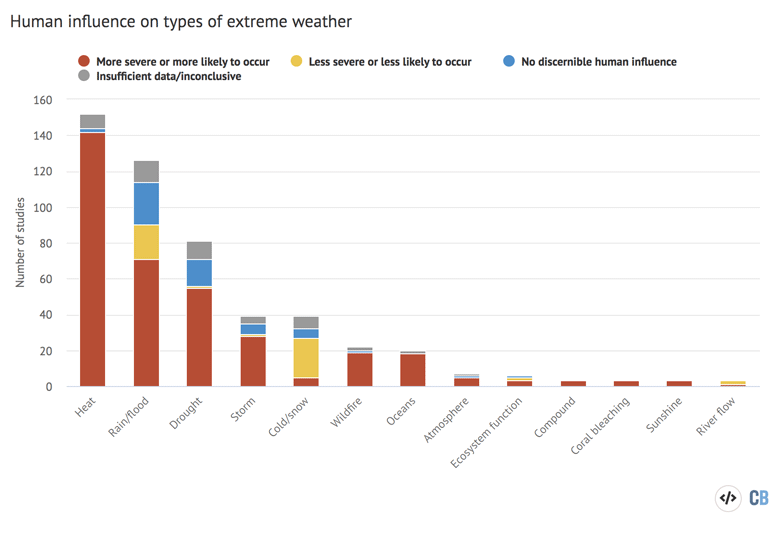
Chart shows the number of studies for each type of extreme event that fall within each category of human influence: More severe/likely (red), less severe/likely (yellow), no influence (blue) and inconclusive (grey). Chart by Carbon Brief using Highcharts.
While attribution studies of heatwaves are generally more straightforward than storms – as they focus on thermodynamic influences – the type of question they are asking is still important. The Russian heatwave in 2010 is a good example of this. One study looking at the severity of the event did not find a role for climate change. Yet another one, which did find an influence, looked at the likelihood of the event.
This apparent contradiction is tackled by a third study that reconciles the other two. It explains that “the same event can be both mostly internally-generated [i.e. by natural variability] in terms of magnitude and mostly externally-driven [i.e. by human-caused climate change] in terms of occurrence probability”.
Otto, who is lead author of the third study, tells Carbon Brief:
“The studies, thus, only appear to be contradictory, but are, in fact, complementary.”
It is also important to stress that the absence of evidence for a link to climate change is not the same as evidence of absence. In other words, it does not necessarily mean there was no human influence, just that a particular analysis did not find one. This is why a single study should never be considered the final word on how climate change influences a given type of extreme weather.
Drought
Of the 81 drought events and trends considered here, climate change was found to have increased the severity or likelihood of 55 (68%). Of the remainder, the likelihood or severity was reduced for one event (1%), while no discernible link with human activity was found for 15 (19%) and 10 (12%) were inconclusive.

Capetonians queue for water at natural springs around the city during the water crisis, January 2018. Credit: tim wege / Alamy Stock Photo
This mixed bag of results reflects the inherent complexity of droughts. And, again, the specific question matters. Conclusions about the role of climate change in a specific drought could depend on whether a study looks at temperature, rainfall or soil moisture, for example.
As the 2015 BAMS report explains:
“Drought continues to be an event type where the results require significant context, and easy answers often remain elusive because of the many meteorological, hydrological, and societal drivers that combine to cause drought.”
(For more on the different ways that droughts can be categorised, see this Carbon Brief guest post from 2018.)
Geographical reach
While much has been achieved in the field of extreme event attribution in a short space of time, scientists are constantly looking for ways to tailor their work to suit the people who might use it.
One major goal since the early days of the field has been to expand extreme event attribution to cover a larger and more diverse geographical area.
Where in the world scientists can carry out attribution studies – and for what kind of events – will always be limited by the quality and availability of observed data and appropriate models. The attribution map highlights, for example, that there are relatively few studies of extreme weather in Africa and South America.
In another example, scientists hoping to analyse Super Typhoon Mangkhut – which hit the Philippines in September 2018 – were unable to in part because of “very poor quality” observed data in publicly available datasets and a lack of models.
At the moment, there is also a heavy leaning towards weather events that are local to the modelling groups, or that have a particular scientific interest. Otto explains:
“For example, scientists often do attribution studies because an event occurs on their doorstep. The UK, California and Boulder [in Colorado] are, therefore, studied much more than other parts of the world, but that does not necessarily make them places particularly impacted by climate change.”
This means that while the studies carried out so far are indicative of the role climate change is playing in extreme weather around the world, they should not be considered representative of all types of extreme weather everywhere, says Otto. She tells Carbon Brief:
“[The studies so far] are part of a picture, but we don’t know what’s on the missing puzzle pieces. And, crucially, we don’t know how many pieces are missing.”
For example, Otto recently penned a Carbon Brief guest post on how the lack of monitoring of heatwaves in Africa means they are a “forgotten impact” of climate change.
Real-time extreme weather attribution
As well as expanding the science to cover different types of weather and more of the world, scientists are getting faster at turning the handle on extreme event attribution studies – sometimes crunching the numbers just days after an event has occurred.
The rapid studies included here are all produced by the World Weather Attribution (WWA) initiative, described earlier, or the UK Met Office.
An example of analysis performed by the latter includes their review of the UK’s weather in 2020, which was published by Carbon Brief. This showed that climate change increased the likelihood of the UK’s warm year by approximately a factor of 50.
While the WWA individual rapid assessments are not individually peer-reviewed, they are conducted using methods that have been through the peer-review process. As the 2014 BAMS report explains:
“Much like other routine analysis, such as an operational seasonal forecast, statements made about heat events using these methods do not necessarily need to go through the peer-reviewed literature to be considered credible.”
By conducting the analysis in the immediate aftermath of a weather event, these rapid studies provide almost-real-time information on the influence of climate change, rather than having to wait many months for a formal study.
(In some cases, these rapid assessments are later published in peer-reviewed journals. In these instances, the formal study is included in the attribution map, rather than the initial analysis. In some cases, this means earlier rapid assessments are removed from the Carbon Brief map in order to add in the relevant peer-reviewed paper once it is published.)
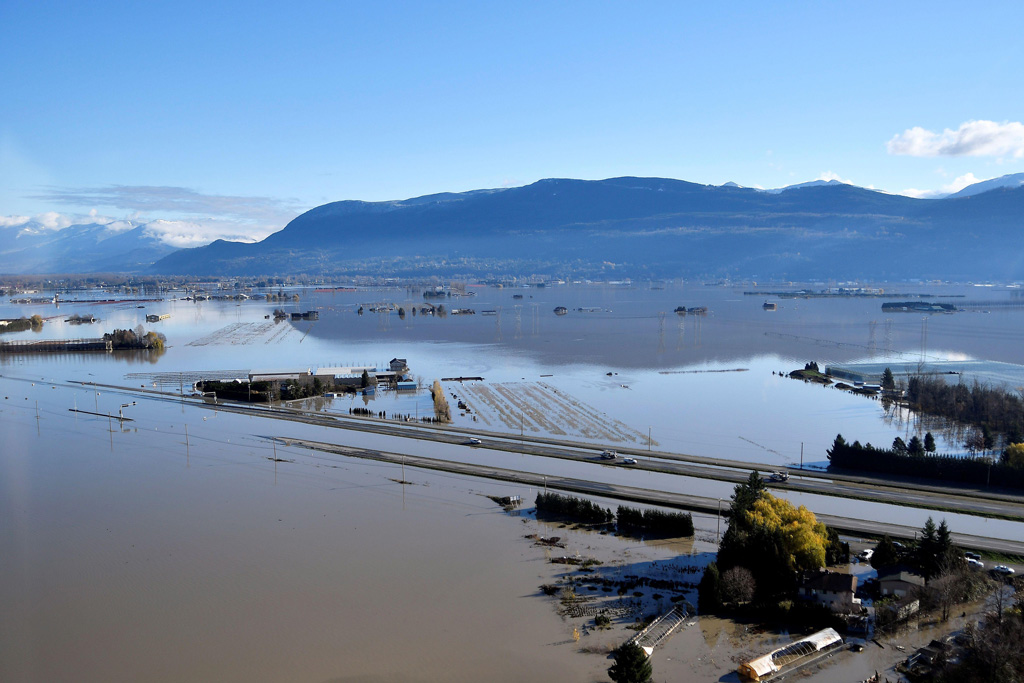
The European Centre for Medium-Range Weather Forecasts (ECMWF) has been working on a pilot “operational attribution service” through the Copernicus Climate Change Service (C3S).
This collaboration between the UK Met Office, German weather service (DWD), Meteo France, Dutch weather service (KNMI) and the University of Oxford will “demonstrate how attribution of extreme weather events can be carried out operationally by national meteorological services”, Prof Stott tells Carbon Brief:
“In this project we are developing and testing the protocols we will need to enable rapid and reliable assessments of the extent to which recent extreme weather events have been made more or less intense or more or less likely by climate change. We started at the beginning of the year and so far we have tested our procedures on an analysis of the 2018 heatwave in Europe.”
The progress to date has “demonstrated the importance of international collaboration for developing new techniques and processes”, says Stott. But “national meteorological services across Europe will continue to have a particular remit to deliver advice on weather and climate in their own countries”, he adds:
“At the Met Office in the UK we are developing our operational attribution capability to help inform the public, policymakers and journalists about the extent to which damaging extreme weather events like the floods in Yorkshire [in 2019] have been affected by climate change.”
An evolving science
As the science of extreme event attribution has matured and become more nuanced, so has the choice of terminology around extreme weather and climate change.
While some attest that all extreme weather must be affected by a world that is warming, this warrants some caution. As the first BAMS report in 2012 noted:
“While it has been argued that in the Anthropocene, all extreme weather or climate events that occur are altered by human influence on climate…this does not mean that climate change can be blamed for every extreme weather or climate event. After all, there has always been extreme weather.”
But while it would be premature to suggest that any single study is the last word, it is clear that – in many cases – the science can do better than that. Similarly, scientific thinking has clearly moved on from the unsatisfactory statement that it is not possible to attribute any individual weather event to climate change. Indeed, as mentioned earlier, there have been some studies that have concluded that an event – or aspect of an event – would have been impossible without climate change.
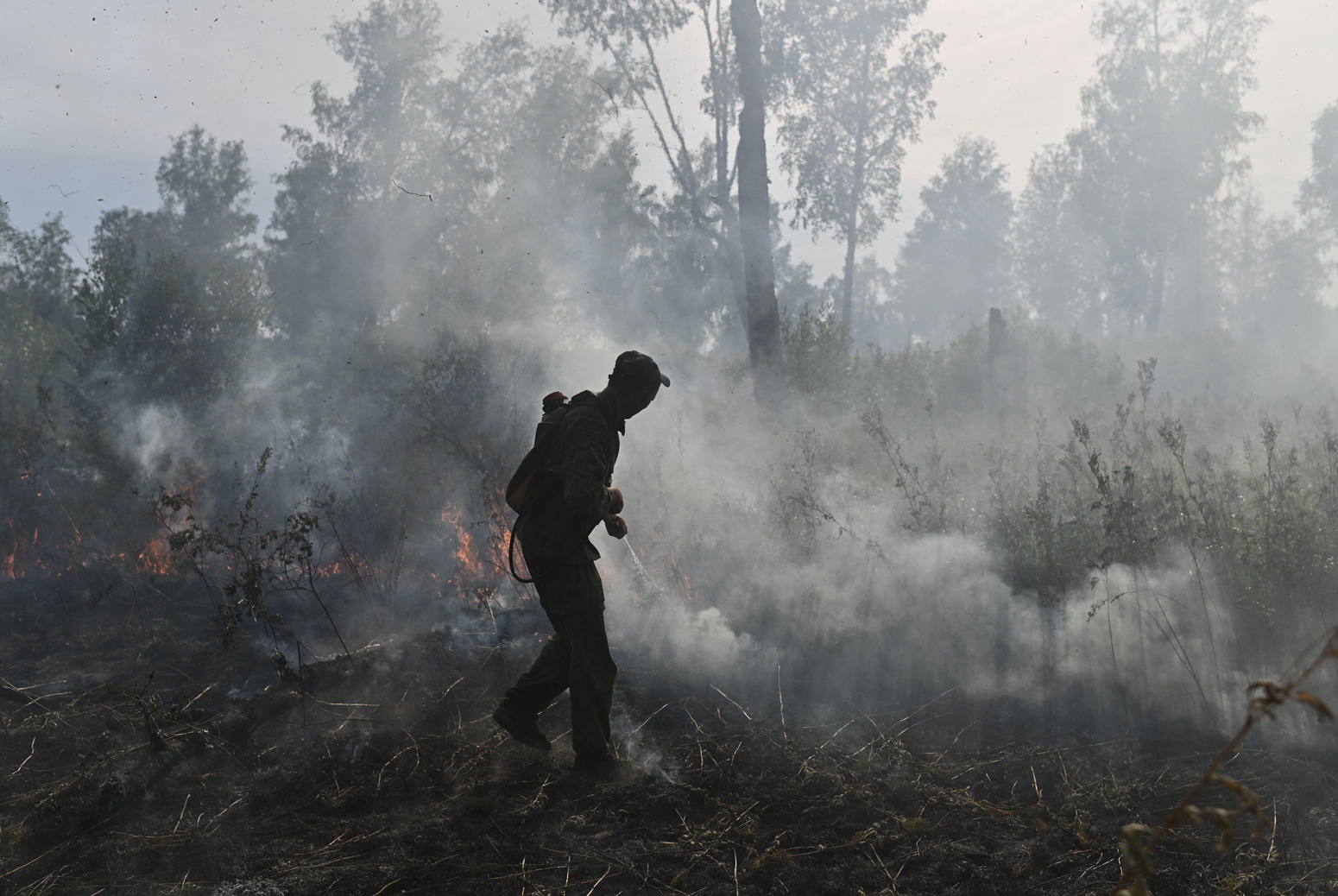
Ultimately, there are no blanket rules in attribution. Scientists need to examine the circumstances of each individual weather event – or a longer pattern of events for trend studies. It is only by combining evidence from all around the world that they can begin to draw broader conclusions.
Attribution studies, therefore, rely heavily on the quality and availability of observational data and climate model simulations. In a short paper for the journal Weather, Dr Otto says that “the models used for attribution need to be able to reliably estimate the likelihoods of the types of events being attributed”.
As discussed earlier, attribution studies of heatwaves tend to be more straightforward because of their focus on thermodynamic effects, rather than atmospheric circulation. Yet, Otto tells Carbon Brief that recent studies suggest models overestimate the year-to-year variability of heat extremes in some parts of the world, and thus underestimate the trend and the role of climate change.
In a rapid attribution study of the western Europe summer heatwave in 2019, for example, Otto and her colleagues found that, for the month of June, the models “show about 50% smaller trends than observations in this part of Europe and much higher year-to-year variability than the observations”. Similarly, a study of the 2019-20 Australian bushfires noted that “models underestimate the observed trend in heat” and so the “real increase could be much higher”.
These findings emphasise how important it is to analyse models and observations together, Otto says:
“This made me realise just how important attribution is for the scientific community – and everyone using climate science – at bringing observations and models together in a very concrete real-world test case.
Attribution can, therefore, be used to help scientists “identify where the models are doing well and for what they are not in a much more direct way than the classical skill assessment of climate projections does”, adds Otto.
Forecasted attribution
One attempt to move attribution science forward was the very first “advance forecasted” attribution analysis, which quantified the impact of climate change on the size, rainfall, and intensity of Hurricane Florence before it made landfall in North Carolina in September 2018.
The analysis ran two sets of short-term forecasts for the hurricane: one as the climate is today and the other in a simulated world without human-caused climate change. The researchers concluded at the time:
“We find that rainfall will be significantly increased by over 50% in the heaviest precipitating parts of the storm. This increase is substantially larger than expected from thermodynamic considerations alone. We further find that the storm will remain at a high category on the Saffir-Simpson scale for a longer duration and that the storm is approximately 80km in diameter larger at landfall because of the human interference in the climate system.”
The analysis received a mixed reaction. Prof Stott told Carbon Brief that it was “quite a cool idea”, but would be dependent on being able to forecast such events reliably. Dr Kevin Trenberth, distinguished senior scientist at the National Center for Atmospheric Research, described it as “a bit of a disaster”. He told Carbon Brief that the quality of the forecast was questionable for the assessment:
“The forecasts made were not good: the intensity of the forecast storm at landfall was category 4 or 5 as I recall, instead of category 2. And so the statements made were based on quite flawed assumptions: namely, that they had a good forecast.”
A key requirement for a reliable attribution study is for models to accurately replicate the extreme event, Trenberth added, but “obviously one can not assess the goodness of the forecast if one does this in advance”.
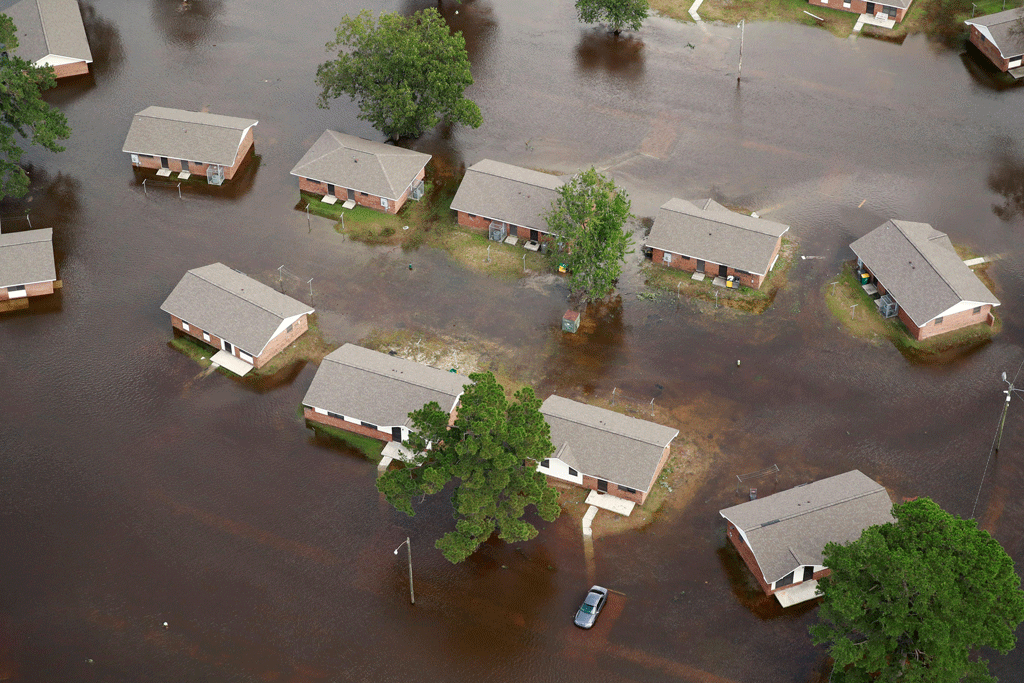
The authors subsequently published a paper in Science Advances that “reviews the forecasted attribution with the benefit of hindsight”. The findings show that climate change increased rainfall amounts “associated with the forecasted storm’s core” by around 5%, and contributed to Hurricane Florence being “about 9km larger in mean maximum diameter (or a 1.6% increase in storm area) due to climate change”.
The authors acknowledged that the “quantitative aspects of our forecasted attribution statements fall outside broad confidence intervals of our hindcasted statements and are quite different from the hindcasted best estimates”. In short, the results are quite a way off what they forecasted.
However, the authors also said they have identified what went wrong with their forecasted analysis. Problems with the way their “without climate change” model runs were set up created a larger contrast against their real-world simulations. The results thus suggested that climate change would have a bigger impact than it actually did.
Nonetheless, the study did identify a quantifiable impact of climate change on Hurricane Florence, adding to the evidence from studies by other author groups, the researchers concluded:
“As the climate continues to warm, it is expected that extreme tropical cyclone precipitation events and resulting inland flooding will become yet more frequent.”
In addition, a 2021 study of the record Australian heat event of October 2015 noted the potential of their methods “to provide attribution statements for forecast events within an outlook period”. This will “allow for informed messaging to be available as required when an extreme event occurs, which is of particular use to weather and climate services”, the authors wrote.
On the topic of forecasts, a 2021 study showed how it was possible to use a weather forecast model for attribution. The researchers, who penned a Carbon Brief guest post about their work, tested their methods using the European heatwave of February 2019 – an event their model successfully predicted:
“We find that the direct impact of the extra carbon dioxide (CO2) that humans have pumped into the atmosphere made the event 42% more likely for the British Isles and at least 100% (two times) more likely for France.”
Their work “so far represents just the first few steps towards an operational forecast-based attribution system”, they noted.
Finally, as well as casting forwards, attribution can also look back in time. A 2020 study on the US “Dust Bowl” heat and drought events of the 1930s takes an unconventional approach of looking at how the past event “would behave” with present-day levels of greenhouse gases.
The researchers find that “the return period of a 1-in-100-year heatwave summer (as observed in 1936) would be reduced to about 1-in-40 years” in today’s climate.
Carbon Brief will continue to add new extreme event attribution studies to the map and update the accompanying analysis every year. Please get in touch with any suggestions of attribution studies that could be included.
The post Mapped: How climate change affects extreme weather around the world appeared first on Carbon Brief.
https://www.carbonbrief.org/mapped-how-climate-change-affects-extreme-weather-around-the-world/
Climate Change
EU refuses to review “strategic” mineral projects for energy transition
The European Commission has rejected requests by green groups to review the status of 16 controversial projects it has designated as “strategic” to shore up the bloc’s supply of critical minerals needed for the energy transition, despite environmental concerns.
Campaigners accused the European Union’s executive arm of being more interested in labelling projects as “strategic” to accelerate their development than ensuring they meet its environmental standards.
Legal experts told Climate Home News that despite the EU’s rhetoric on developing sustainable mining standards, it will be very difficult for local communities and NGOs to use the judicial system to enforce compliance with environmental safeguards.
Earlier this year, the European Commission labelled 47 mineral extraction, processing and recycling projects within EU member states as “strategic“, granting them preferential treatment for gaining permits and easier access to EU funding.
Spanning from the north of Sweden to Portugal and southern Spain, these projects are due to help the EU reach targets for sourcing more of the minerals it needs for clean energy and digital technologies within its own borders in an environmentally friendly way, while reducing its dependence on imports from China.
However, NGOs and local communities have accused the European Commission of a lack of transparency and of failing to engage civil society over the selection of these projects, most of which are in the early stages of development and are yet to obtain the necessary permits or conduct detailed environmental impact assessments.
Civil society groups challenged the decision to include around a third of projects on the strategic list, arguing that the commission had not properly assessed their sustainability. They also cited risks of social and environmental harm and human rights violations.
EU: Environmental compliance lies with member states
In total, 11 requests for review covering 16 of the projects planned within the EU were filed under the Aarhus Regulation, which gives NGOs the right to ask the European Commission to review administrative decisions if they are considered to violate the bloc’s environmental law.
In a single response shared with green groups this week, and seen by Climate Home News, the commission found that the requests to review the projects’ status were “unfounded”.
“A thorough assessment confirmed that all points raised by the NGOs had already been properly addressed during the selection process. All the projects concerned therefore retain their status as strategic projects,” a European Commission spokesperson told Climate Home News. They did not respond to detailed questions about their assessment.
Under the EU’s Critical Raw Materials Act, which was adopted last year, the commission can designate mineral projects as strategic if they meet a shortlist of criteria, including that the project “would be implemented sustainably” and monitor, prevent and minimise environmental and adverse social impacts.
The strategic status can be revoked if projects no longer meet the criteria.
However, the commission said it was not its job to carry out a full and detailed assessment of whether the projects fully comply with EU environmental laws, adding that it is only required to make an “overall assessment”.
Rather, it argued, member states have the responsibility to ensure the projects fully comply with EU environmental standards including impacts on biodiversity and ground water as well as waste management.
The commission also refused to examine the social impacts of the projects on community livelihoods, health and human rights – which could arise from environmental degradation – arguing that this was outside the scope of the review mechanism under the Aarhus Regulation.
Campaigners have strongly criticised the response.
“Cosmetic”sustainability criteria
Ilze Tralmaka, a lawyer at Client Earth, told Climate Home News the commission’s decision showed that the designation of mineral projects as “strategic” doesn’t make them safe or sustainable, despite creating a legal presumption that they serve the public interest and protect public health and safety.
“While on paper, there is mention of sustainability, in practice, it’s almost cosmetic,” she said. “It seems the environmental standards are just briefly looked at and that the policy of declaring these projects as strategic is more important than real engagement with the sustainability criteria.”
Client Earth argues that while securing supplies of minerals for the energy transition is a legitimate goal, the status of strategic project is being “misused” to fast-track questionable mining projects.
Tralmaka said the European Commission should engage where there are “unanswered questions, or if there is credible information about these projects being potentially unsafe”.
Client Earth was part of a group of NGOs that challenged the decision to designate the Barroso lithium project in Portugal as a strategic project.


“Textbook example of how not to do a green transition”
London-listed Savannah Resources is planning to dig four open pit mines in the northern Barroso region to extract lithium from Europe’s largest known deposit. The company says it will extract enough lithium every year to produce around half a million batteries for electric vehicles.
However, local groups have staunchly opposed the mining project, citing concerns over waste management and water use as well as the impact of the mine on traditional agriculture in the area.
Earlier this year, a UN committee found that Portugal had failed to respect citizens’ rights to information and public participation in the case of the Barroso project. Portuguese authorities denied the breach.
Efforts to green lithium extraction face scrutiny over water use
The commission said it was satisfied with the project’s overall sustainability credentials and that campaign groups should take a case to their national court if they are concerned about the legality of any project.
“This decision shows that the EU is willing to trade rural lives and irreplaceable landscapes for a political headline,” said Nik Völker of MiningWatch Portugal. “The truth is, the Mina do Barroso mine offers minimal benefits and enormous risks: a textbook example of how not to do a green transition.”
Savannah Resources did not respond to a request for comment.
“Murky” standards make legal challenge hard
Simon Simanovski, a business and human rights attorney with German law firm Günther Rechtsanwälte, has advised dozens of communities affected by projects designated as “strategic” under the EU’s Critical Raw Materials Act over the past year.
For him, the commission’s response creates a disconnect between its role as a decision-making body and the responsibility for enforcing the bloc’s environmental laws, by pushing it to member states. That, he said, creates “murky standards”.
This, he added, will make it “really difficult” to challenge inadequate environmental safeguards through the courts. “It means that there is no effective judicial protection… and that the projects will happen,” he told Climate Home News.
However, Simanovski still expects some campaign groups to try filing a case before the general court of the European Court of Justice to challenge the European Commission’s response and ask it to review its assessment of the projects.
Simanovski represents communities in Serbia that are also challenging the “strategic” designation of the Jadar lithium mine – one of an additional 13 “strategic projects” located outside EU countries – which has seen massive local opposition.
The commission is expected to respond to requests to review those external strategic projects in January.
The post EU refuses to review “strategic” mineral projects for energy transition appeared first on Climate Home News.
EU refuses to review “strategic” mineral projects for energy transition
Climate Change
DeBriefed 28 November 2025: COP30’s ‘frustrating’ end; Asia floods; UK ‘emergency’ climate event
Welcome to Carbon Brief’s DeBriefed.
An essential guide to the week’s key developments relating to climate change.
This week
‘Lukewarm’ end to COP30
BYE BELÉM: The COP30 climate talks in Belém ended last weekend with countries agreeing on a goal to “triple” adaptation finance by 2035 and efforts to “strengthen” climate plans, Climate Home News reported. The final deal “fell short on the global transition away from oil, gas and coal”, the outlet said, as Brazil announced that it would bring forward voluntary roadmaps to phase out fossil fuels and deforestation, before the next COP. It was a “frustrating end” for more than 80 countries who wanted a roadmap away from fossil fuels to be part of the formal COP agreement, BBC News said.
WHAT HAPPENED?: Carbon Brief published its in-depth analysis of all the key outcomes from COP30, spanning everything from negotiations on adaptation, just transition, gender and “Article 6” carbon trading through to a round-up of pledges on various issues. Another Carbon Brief article summed up outcomes around food, forests, land and nature. Also, Carbon Brief journalists discussed the COP in a webinar held earlier this week.
ART OF THE DEAL: The “compromise” COP30 deal – known as the “global mutirão” – “exposed deep rifts over how future climate action should be pursued”, Reuters noted. The “last-ditch” agreement was reached after fossil-fuel wording negotiations between the EU and Saudi Arabia, according to the Guardian. Meanwhile, Carbon Brief revealed the “informal” list of 84 countries said to have “opposed” the inclusion of a fossil-fuel roadmap in the mutirão decision, but analysis of the list exposed contradictions and likely errors.
UNITY, SCIENCE, SENSE: The final agreement received “lukewarm praise”, said the Associated Press. Palau ambassador Ilana Seid, who chaired the coalition of small-island nations, told the newswire: “Given the circumstances of geopolitics today, we’re actually quite pleased…The alternative is that we don’t get a decision and that would have been [worse].” UN climate chief Simon Stiell said that amid “denial, division and geopolitics”, countries “chose unity, science and economic common sense”, reported the Press Trust of India.
Around the world
- Floods and landslides killed more than 200 people in Thailand and Indonesia this week, reported Bloomberg. At least 90 people also died in recent floods in Vietnam, said Al Jazeera.
- New measures to cut energy bills and a “pay-per-mile” electric-vehicle levy were among the announcements in the UK’s budget, said Carbon Brief.
- The Group of 20 (G20) leaders signed off on a declaration “addressing the climate crisis” and other issues, reported Reuters, which had no input from the US who boycotted last week’s G20 summit in South Africa.
- Canadian prime minister Mark Carney signed a deal with the province of Alberta “centred on plans for a new heavy oil pipeline”, said the Guardian, adding that Canadian culture minister and former environment minister, Steven Guilbeault, resigned from cabinet over the deal.
- Greenpeace analysis, covered by Reuters, found that permits for new coal plants in China are “on track to fall to a four-year low” in 2025.
27
The number of hours that COP30 talks went over schedule before ending in Belém last Saturday, making it the 11th-longest UN climate summit on record, according to analysis by Carbon Brief.
Latest climate research
- The risk of night-time deaths during heatwaves increased “significantly” over 2005-15 in sub-Saharan Africa | Science Advances
- Almost half of climate journalists surveyed showed “moderate to severe” symptoms of anxiety | Traumatology
- Lakes experienced “more severe” heatwaves than those in the atmosphere over the past two decades | Communications Earth & Environment
(For more, see Carbon Brief’s in-depth daily summaries of the top climate news stories on Monday, Tuesday, Wednesday, Thursday and Friday.)
Captured
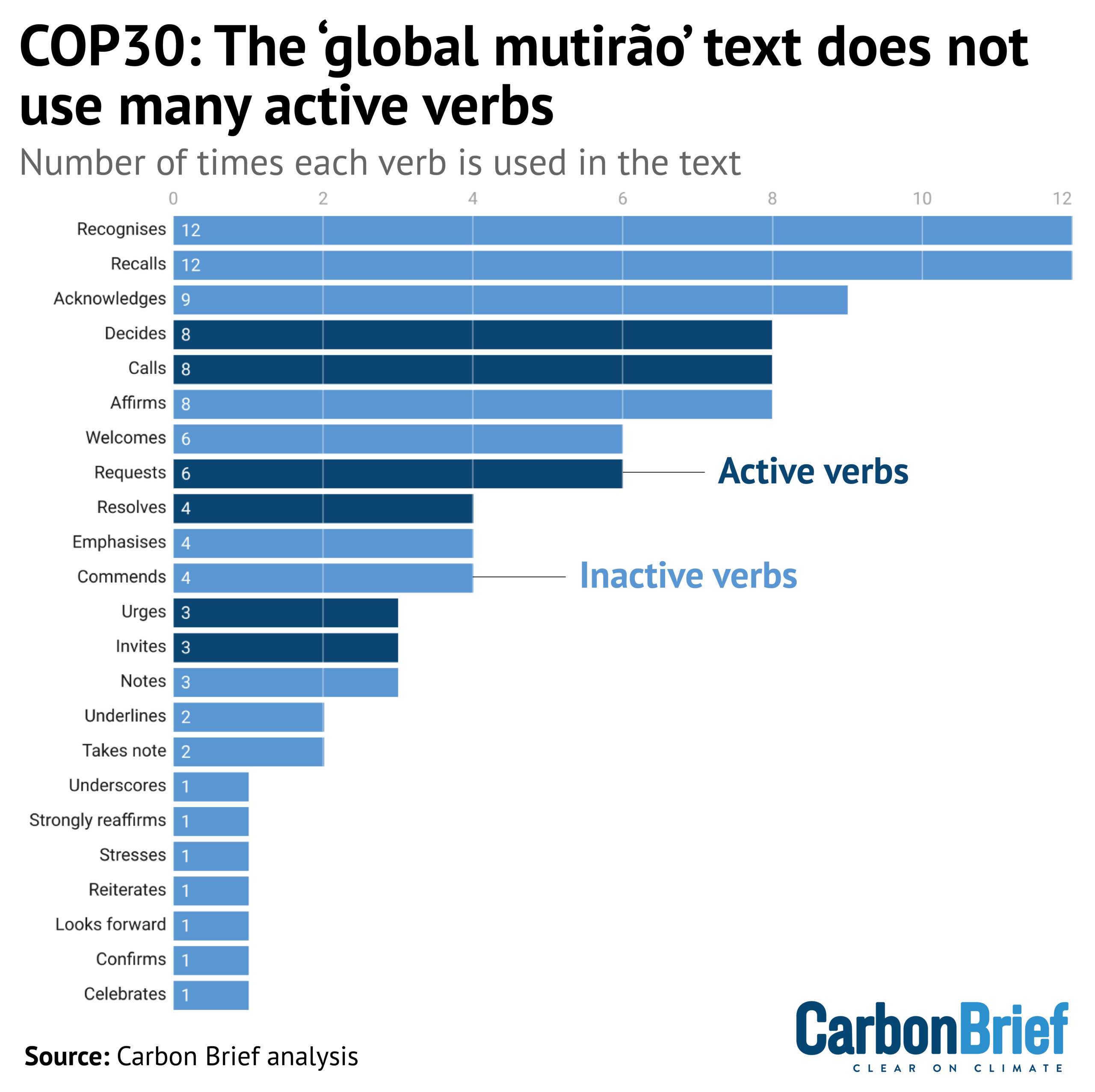
The key COP30 agreement – termed the “global mutirão” – contained 69 inactive verbs, which require no action from countries, compared to 32 active ones. “Recognises”, “recalls” and “acknowledges” were used far more often than more active verbs, such as “decides”, “calls” and “requests”, showed Carbon Brief analysis.
Spotlight
Nine warnings from a UK climate and nature ‘emergency’ briefing
This week, Carbon Brief’s Orla Dwyer reports from an event where experts and campaigners sounded the alarm bell on climate change and nature loss.
Naturalist and broadcaster Chris Packham urged attendees at a climate and nature “emergency briefing” in London yesterday to “listen to the science” on climate change amid a “dangerous wave of misinformation and lies”.
The “first-of-its-kind” event heard from nine experts on the links between climate change, nature loss, health, food production, economics and national security.
Event host, Prof Mike Berners-Lee from Lancaster University, called for a “World War II level of leadership” to tackle the interconnected crises.
Hundreds of people showed up, including Green Party, Labour and Liberal Democrat MPs, leader of the Greens Zack Polanski, musician Brian Eno and actress Olivia Williams.
Here is a snapshot of what the nine speakers said in their short, but stark, presentations.
Prof Kevin Anderson, professor of energy at University of Manchester
Anderson focused on the risks of a warmer world and the sliver of emissions left in the global carbon budget, noting:
“We have to eliminate fossil fuels or temperatures will just keep going up.”
He urged a “Marshall-style” plan – referencing the 1948 post-war US plan to rebuild Europe – to ramp up actions on retrofitting, public transport and electrification.
Prof Nathalie Seddon, professor of biodiversity at University of Oxford
Nature is not a “nice to have”, but rather “critical national infrastructure”, Seddon told attendees. She called for the “need to create an economy that values nature”.
Prof Paul Behrens, British Academy global professor at University of Oxford
Behrens discussed the food security risks from climate change. Impacts such as poor harvests and food price inflation are “barely acknowledge[d]” in agricultural policy, he said.
He also emphasised the “unsustainable” land use of animal agriculture, which “occupies around 85% of total agricultural land” in the UK.
Prof Tim Lenton, chair in climate change and Earth system science at Exeter University
Lenton outlined the “plenty” of evidence that parts of the Earth system are hurtling towards climate tipping points that could push them irreversibly into a new state.
He discussed the possibility of the shutdown of the Atlantic Meridional Overturning Circulation, which he said could cause -20C winters in London. He also noted positive tipping points, such as momentum that led the UK to stop burning coal for electricity last year.
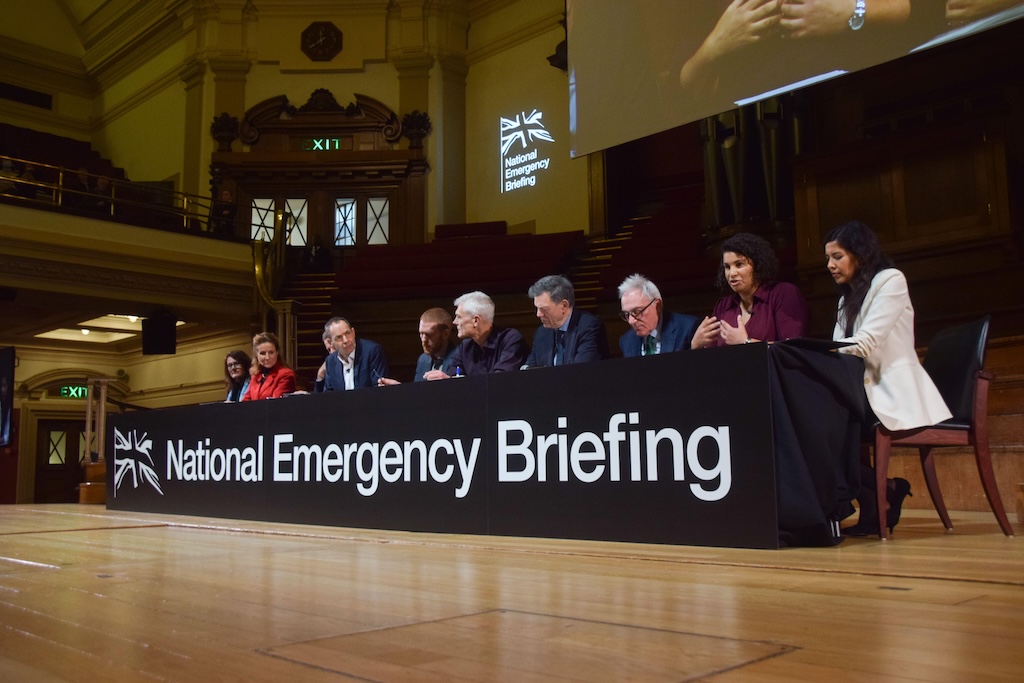
Prof Hayley Fowler, professor of climate change impacts at Newcastle University
One in four properties in England could be at risk of flooding by 2050, Fowler said, and winters are getting wetter.
She discussed extreme weather risks and listed the impacts of floods in recent years in Germany, Spain and Libya, adding:
“These events are not warnings of what might happen in the future. They’re actually examples of what is happening right now.”
Angela Francis, director of policy solutions at WWF-UK
Francis factchecked several claims made against climate action, such as the high cost of achieving net-zero.
She noted that the estimated cost for the UK to achieve net-zero is about £4bn per year, which is less than 0.2% of GDP.
Lieutenant general Richard Nugee, climate and security advisor
Discussing the risks climate change poses to national security, Nugee said:
“Climate change can be thought of as a threat multiplier, making existing threats worse or more frequent and introducing new threats. Climate shocks fuel global instability.”
Tessa Khan, environmental lawyer and executive director of Uplift
Khan said the rising cost of energy in the UK is “turning into a significant political risk for the energy transition”.
She discussed the cost of fossil-fuel dependency and the fact that these fuels cost money to burn, but renewable “input[s], sun or wind [are] free forever”.
Prof Hugh Montgomery, professor of intensive care medicine at University College London
Montgomery discussed the health and economic benefits of climate actions, such as eating less meat and using more public transport, noting:
“The climate emergency is a health emergency – and it’s about time we started treating it as one.”
Watch, read, listen
WATER WORRIES: ABC News spoke to three Iranian women about the impacts of Tehran’s water crisis amid the “worst drought in 60 years”.
CLIMATE EFFORT: The BBC’s Climate Question podcast looked at the main outcomes from COP30 and discussed the “future of climate action” with a team of panelists.
CRIMINAL BEHAVIOUR:New Scientist interviewed criminal psychologist Julia Shaw about the psychology behind environmental crimes.
Coming up
- 24 November-5 December: COP20 on international trade in endangered species of wild fauna and flora, Samarkand, Uzbekistan
- 29-30 November: First part of global youth environment assembly, Nairobi, Kenya
- 3-4 December: Second round of Egyptian parliamentary elections
- 5 December: World soil day, global
Pick of the jobs
- Aldersgate Group, head of policy | Salary: £56,650-£66,950 per year. Location: London
- Ofgem, climate resilience expert | Salary: £61,446-£86,547. Location: Cardiff, Glasgow or London
- Green Climate Fund, integrity risk management lead | Salary: $171,200. Location: Incheon, South Korea
- Isles of Scilly Wildlife Trust, project manager – seabird recovery | Salary: Up to £45,000 per year. Location: Isles of Scilly, UK
DeBriefed is edited by Daisy Dunne. Please send any tips or feedback to debriefed@carbonbrief.org.
This is an online version of Carbon Brief’s weekly DeBriefed email newsletter. Subscribe for free here.
The post DeBriefed 28 November 2025: COP30’s ‘frustrating’ end; Asia floods; UK ‘emergency’ climate event appeared first on Carbon Brief.
DeBriefed 28 November 2025: COP30’s ‘frustrating’ end; Asia floods; UK ‘emergency’ climate event
Climate Change
Revealed: Leak casts doubt on COP30’s ‘informal list’ of fossil-fuel roadmap opponents
A confused – and, at times, contradictory – story has emerged about precisely which countries and negotiating blocs were opposed to a much-discussed “roadmap” deal at COP30 on “transitioning away from fossil fuels”.
Carbon Brief has obtained a leaked copy of the 84-strong “informal list” of countries that, as a group, were characterised across multiple media reports as “blocking” the roadmap’s inclusion in the final “mutirão” deal across the second week of negotiations at the UN climate summit in Belém.
During the fraught closing hours of the summit, Carbon Brief understands that the Brazilian presidency told negotiators in a closed meeting that there was no prospect of reaching consensus on the roadmap’s inclusion, because there were “80 for and 80 against”.
However, Carbon Brief’s analysis of the list – which was drawn up informally by the presidency – shows that it contains a variety of contradictions and likely errors.
Among the issues identified by Carbon Brief is the fact that 14 countries are listed as both supporting and opposing the idea of including a fossil-fuel roadmap in the COP30 outcome.
In addition, the list of those said to have opposed a roadmap includes all 42 of the members of a negotiating group present in Belém – the least-developed countries (LDCs) – that has explicitly told Carbon Brief it did not oppose the idea.
Moreover, one particularly notable entry on the list, Turkey – which is co-president of COP31 – tells Carbon Brief that its inclusion is “wrong”.
Negotiating blocs
COP28, held in Dubai in 2023, had finalised the first “global stocktake”, which called on all countries to contribute to global efforts, including a “transition away from fossil fuels”.
Since then, negotiations on how to take this forward have faltered, including at COP29 in Baku, Azerbaijan, where countries were unable to agree to include this fossil-fuel transition as part of existing or new processes under the UN climate regime.
Ahead of the start of COP30, Brazilian president Luiz Inácio Lula da Silva made a surprise call for “roadmaps” on fossil-fuel transition and deforestation.
While this idea was not on the official agenda for COP30, it had been under development for months ahead of the summit – and it became a key point of discussion in Belém.
Ultimately, however, it did not become part of the formal COP30 outcome, with the Brazilian presidency instead launching a process to draw up roadmaps under its own initiative.
This is because the COP makes decisions by consensus. The COP30 presidency insisted that there was no prospect of consensus being reached on a fossil-fuel roadmap, telling closed-door negotiations that there were “80 for and 80 against”.
The list of countries supporting a roadmap as part of the COP30 outcome was obtained by Carbon Brief during the talks. Until now, however, the list of those opposed to the idea had not been revealed.
Carbon Brief understands that this second list was drawn up informally by the Brazilian presidency after a meeting attended by representatives of around 50 nations. It was then filled out to the final total of 84 countries, based on membership of negotiating alliances.
The bulk of the list of countries opposing a roadmap – some 39 nations – is made up of two negotiating blocs that opposed the proposal for divergent reasons (see below). Some countries within these blocs also held different positions on why – or even whether – they opposed the roadmap being included in the COP30 deal.
These blocs are the 22-strong Arab group – chaired in Belém by Saudi Arabia – and the 25 members of the “like-minded developing countries” (LMDCs), chaired by India.
For decades within the UN climate negotiations, countries have sat within at least one negotiating bloc rather than act in isolation. At COP30, the UN says there were 16 “active groups”. (Since its invasion of Ukraine, Russia has not sat within any group.)
The inclusion on the “informal list” (shown in full below) of both the LMDCs and Arab group is accurate, as confirmed by the reporting of the International Institute for Sustainable Development’s Earth Negotiations Bulletin (ENB), which is the only organisation authorised to summarise what has happened in UN negotiations that are otherwise closed to the media.
Throughout the fortnight of the talks, both the LMDCs and Arab group were consistent – at times together – in their resistance to proscriptive wording and commitments within any part of the COP30 deal around transitioning away from fossil fuels.
But the reasons provided were nuanced and varied and cannot be characterised as meaning both blocs simply did not wish to undertake the transition – in fact, all countries under the Paris Agreement had already agreed to this in Dubai two years ago at COP28.
However, further analysis by Carbon Brief of the list shows that it also – mistakenly – includes all of the members of the LDCs, bar Afghanistan and Myanmar, which were not present at the talks. In total, the LDCs represented 42 nations in Belém, ranging from Bangladesh and Benin through to Tuvalu and Tanzania.
Some of the LDC nations had publicly backed a fossil-fuel roadmap.
‘Not correct’
Manjeet Dhakal, lead adviser to the LDC chair, tells Carbon Brief that it is “not correct” that the LDCs, as a bloc, opposed a fossil-fuel roadmap during the COP30 negotiations.
He says that the group’s expectations, made public before COP, clearly identified transitioning away from fossil fuels as an “urgent action” to keep the Paris Agreement’s 1.5C goal “within reach”. He adds:
“The LDC group has never blocked a fossil-fuel roadmap. [In fact], a few LDCs, including Nepal, have supported the idea.”
Dhakal’s statement highlights a further confusing feature of the informal list – 14 countries appear on both of the lists of supporters and opposers. This is possible because many countries sit within two or more negotiating blocs at UN climate talks.
For example, Kiribati, Solomon Islands and Tuvalu are members of both the “alliance of small island states” (AOSIS) and the LDCs.
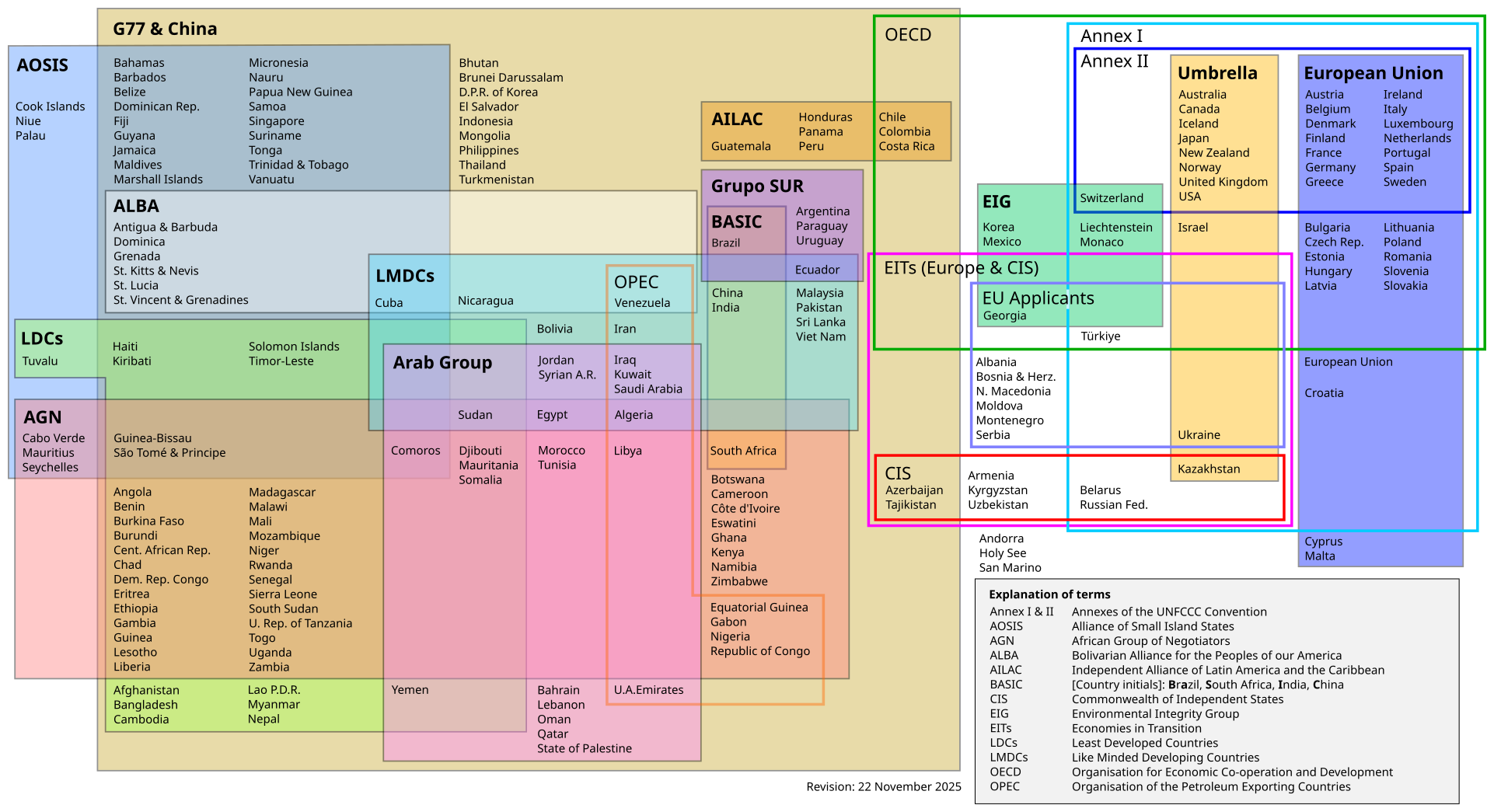
As is the case with the “informal list” of opposers, the list of supporters (which was obtained by Carbon Brief during the talks) is primarily made up of negotiating alliances.
Specifically, it includes AOSIS, the “environmental integrity group” (EIG), the “independent association of Latin America and the Caribbean” (AILAC) and the European Union (EU).
In alphabetical order, the 14 countries on both lists are: Bahrain; Bulgaria; Comoros; Cuba; Czech Republic; Guinea-Bissau; Haiti; Hungary; Kiribati; Nepal; Sierra Leone; Solomon Islands; Timor-Leste; and Tuvalu.
This obvious anomaly acts to highlight the mistaken inclusion of the LDCs on the informal list of opposers.
The list includes 37 of the 54 nations within the Africa group, which was chaired by Tanzania in Belém.
But this also appears to be a function of the mistaken inclusion of the LDCs in the list, many of which sit within both blocs.
Confusion
An overview of the talks published by the Guardian this week reported:
“Though [Brazil’s COP30 president André Corrêa do Lago] told the Guardian [on 19 November] that the divide over the [roadmap] issue could be bridged, [he] kept insisting 80 countries were against the plan, though these figures were never substantiated. One negotiator told the Guardian: ‘We don’t understand where that number comes from.’
“A clue came when Richard Muyungi, the Tanzanian climate envoy who chairs the African group, told a closed meeting that all its 54 members aligned with the 22-member Arab Group on the issue. But several African countries told the Guardian this was not true and that they supported the phaseout – and Tanzania has a deal with Saudi Arabia to exploit its gas reserves.”
Adding to the confusion, the Guardian also said two of the most powerful members of the LMDCs were not opposed to a roadmap, reporting: “China, having demurred on the issue, indicated it would not stand in the way [of a roadmap]; India also did not object.”
Writing for Climate Home News, ActionAid USA’s Brandon Wu said:
“Between rich country intransigence and undemocratic processes, it’s understandable – and justifiable – that many developing countries, including most of the Africa group, are uncomfortable with the fossil-fuel roadmap being pushed for at COP30. It doesn’t mean they are all ‘blockers’ or want the world to burn, and characterising them as such is irresponsible.
“The core package of just transition, public finance – including for adaptation and loss and damage – and phasing out fossil fuels and deforestation is exactly that: a package. The latter simply will not happen, politically or practically, without the former.”
Carbon Brief understands that Nigeria was a vocal opponent of the roadmap’s inclusion in the mutirão deal during the final hours of the closed-door negotiations, but that does not equate to it opposing a transition away from fossil fuels. This is substantiated by the ENB summary:
“During the…closing plenary…Nigeria stressed that the transition away from fossil fuels should be conducted in a nationally determined way, respecting [common, but differentiated responsibilities and respective capabilities].”
The “informal list” of opposers also includes three EU members – Bulgaria, the Czech Republic and Hungary.
The EU – led politically at the talks by climate commissioner Wopke Hoekstra, but formally chaired by Denmark – was reportedly at the heart of efforts to land a deal that explicitly included a “roadmap” for transitioning away from fossil fuels.
Carbon Brief understands that, as part of the “informal intelligence gathering” used to compile the list, pre-existing positions on climate actions by nations were factored in rather than only counting positions expressed at Belém. For example, Hungary and the Czech Republic were reported to have been among those resisting the last-minute “hard-fought deal” by the EU on its 2040 climate target and latest Paris Agreement climate pledge.
(Note that EU members Poland and Italy did not join the list of countries supporting a fossil-fuel roadmap at COP30.)
The remaining individual nations on the informal list either have economies that are heavily dependent on fossil-fuel production (for example, Russia and Brunei Darussalam), or are, like the US, currently led by right-leaning governments resistant to climate action (for example, Argentina).
Turkey is a notable inclusion on the list because it was agreed in Belém that it will host next year’s COP31 in Antalya, but with Australia leading the negotiation process. In contrast, Australia is on the 85-strong list of roadmap supporters.
However, a spokesperson for Turkey’s delegation in Belem has told Carbon Brief that it did not oppose the roadmap at COP30 and its inclusion on the list is “wrong”.
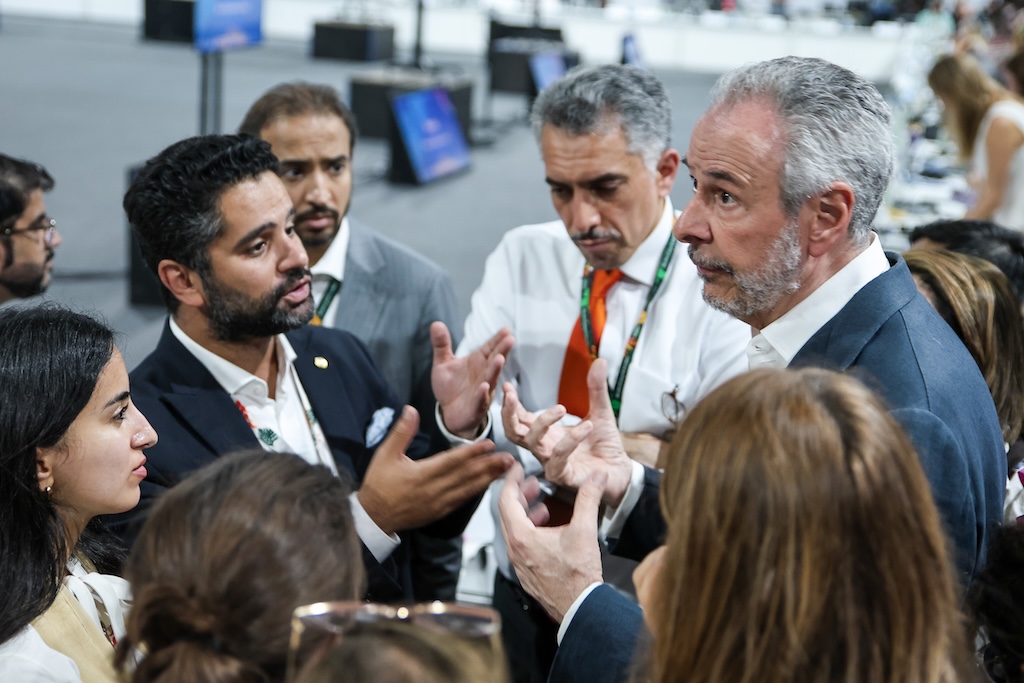
Media characterisations
Some media reporting of the roadmap “blockers” sought to identify the key proponents.
For example, the Sunday Times said “the ‘axis of obstruction’ – Saudi Arabia, Russia and China – blocked the Belém roadmap”.
Agence France-Presse highlighted the views of a French minister who said: “Who are the biggest blockers? We all know them. They are the oil-producing countries, of course. Russia, India, Saudi Arabia. But they are joined by many emerging countries.”
Reuters quoted Vanuatu’s climate minister alleging that “Saudi Arabia was one of those opposed”.
The Financial Times said “a final agreement [was] blocked again and again by countries led by Saudi Arabia and Russia”.
Bloomberg said the roadmap faced “stiff opposition from Arab states and Russia”.
Media coverage in India and China has pushed back at the widespread portrayals of what many other outlets had described as the “blockers” of a fossil-fuel roadmap.
The Indian Express reported:
“India said it was not opposed to the mention of a fossil-fuel phaseout plan in the package, but it must be ensured that countries are not called to adhere to a uniform pathway for it.”
Separately, speaking on behalf of the LMDCs during the closing plenary at COP30, India had said: “Adaptation is a priority. Our regime is not mitigation centric.”
China Daily, a state-run newspaper that often reflects the government’s official policy positions, published a comment article this week stating:
“Over 80 countries insisted that the final deal must include a concrete plan to act on the previous commitment to move beyond coal, oil, and natural gas adopted at COP28…But many delegates from the global south disagreed, citing concerns about likely sudden economic contraction and heightened social instability. The summit thus ended without any agreement on this roadmap.
“Now that the conference is over, and emotions are no longer running high, all parties should look objectively at the potential solution proposed by China, which some international media outlets wrongly painted as an opponent to the roadmap.
“Addressing an event on the sidelines of the summit, Xia Yingxian, deputy head of China’s delegation to COP30, said the narrative on transitioning away from fossil fuels would find greater acceptance if it were framed differently, focusing more on the adoption of renewable energy sources.”
Speaking to Carbon Brief at COP30, Dr Osama Faqeeha, Saudi Arabia’s deputy environment minister, refused to be drawn on whether a fossil-fuel roadmap was a red line for his nation, but said:
“I think the issue is the emissions, it’s not the fuel. And our position is that we have to cut emissions regardless.”
Neither the Arab group nor the LMDCs responded to Carbon Brief’s invitation to comment on their inclusion on the list.
The Brazilian COP30 presidency did not respond at the time of publication.
While the fossil-fuel roadmap was not part of the formal COP30 outcome, the Brazilian presidency announced in the closing plenary that it would take the idea forward under its own initiative, drawing on an international conference hosted in Colombia next year.
Corrêa do Lago told the closing plenary:
“We know some of you had greater ambitions for some of the issues at hand…As president Lula said at the opening of this COP, we need roadmaps so that humanity, in a just and planned manner, can overcome its dependence on fossil fuels, halt and reverse deforestation and mobilise resources for these purposes.
“I, as president of COP30, will therefore create two roadmaps, one on halting and reverting deforestation, another to transitioning away from fossil fuels in a just, orderly and equitable manner. They will be led by science and they will be inclusive with the spirit of the mutirão.
“We will convene high level dialogues, gathering key international organisations, governments from both producing and consuming countries, industry workers, scholars, civil society and will report back to the COP. We will also benefit from the first international conference for the phase-out of fossil fuels, scheduled to take place in April in Colombia.”
Fossil-fuel roadmap
‘Supporters’
Both ‘supporter’ and ‘opposer’
‘Opposers’
Additional reporting by Daisy Dunne.
The post Revealed: Leak casts doubt on COP30’s ‘informal list’ of fossil-fuel roadmap opponents appeared first on Carbon Brief.
Revealed: Leak casts doubt on COP30’s ‘informal list’ of fossil-fuel roadmap opponents
-
Climate Change4 months ago
Guest post: Why China is still building new coal – and when it might stop
-
Greenhouse Gases4 months ago
Guest post: Why China is still building new coal – and when it might stop
-
Climate Change2 years ago
Spanish-language misinformation on renewable energy spreads online, report shows
-

 Greenhouse Gases2 years ago
Greenhouse Gases2 years ago嘉宾来稿:满足中国增长的用电需求 光伏加储能“比新建煤电更实惠”
-
Climate Change Videos2 years ago
The toxic gas flares fuelling Nigeria’s climate change – BBC News
-

 Climate Change2 years ago
Climate Change2 years ago嘉宾来稿:满足中国增长的用电需求 光伏加储能“比新建煤电更实惠”
-

 Carbon Footprint2 years ago
Carbon Footprint2 years agoUS SEC’s Climate Disclosure Rules Spur Renewed Interest in Carbon Credits
-
Renewable Energy5 months ago
US Grid Strain, Possible Allete Sale


